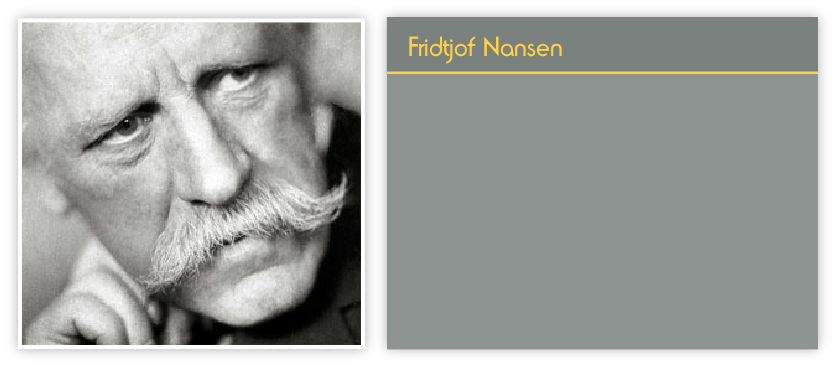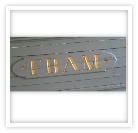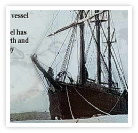

Born: 10 Oct. 1861, Store Frøen near Christiania, now Oslo, Norway.
Died: 13 May 1930, Lysaker, near Oslo, Norway.
Fridtjof Nansen was an extra ordinary man.
He captured the imagination of many and equally inspired many. A few famous quotes of Fridtjof:
“The difficult is what takes a little time; the impossible is what takes a little longer”
“It’s better to go skiing and think of God, then go to church and think of sport”




He was first to cross the Greenland Ice Sheet and first to cross the Arctic Ocean. Nansen attended school in Christiania (now Oslo) and took the entrance exam to the University of Christiania (now Univ. of Oslo) in 1880. He studied zoology. He loved the outdoors, was an athlete and an artist. In 1882, he was appointed curator of zoology at the Bergen Museum, and in 1887 he received the Ph.D. degree from the University of Christiania for a dissertation on the central nervous system.
His first oceanic trip was on the Viking sealing ship to Greenland waters. There he began to develop a plan for an expedition to cross the Greenland Ice Sheet. He announced his plan in 1887 to cross Greenland from east to west. All previous expeditions had attempted the crossing from west to east; all had failed miserably. Nansen adapted Lapp ski and sled techniques, as well as Eskimo snowshoes. He learned the Eskimo language beforehand, as part of his thorough preparation.
Nansen, Otto Sverdrup and four other companions departed Norway in May 1888. After weather delays, they were set on the east coast of Greenland in July, 200 miles (300 km) south of their intended starting point. They journeyed north and finally began the crossing on August 15th. This was several weeks later than originally planned. During the crossing, they endured extreme cold (-70°F) and snowstorms. They were able to "sail" sleds over hard ice at times. They reached a maximum altitude of 8920 feet elevation. The party eventually made the west coast on September 26th. There, they constructed small boats of willow branches and sail cloth to sail to Godthåb, the Danish capital of Greenland. Because of their late arrival, they missed the last ship back to Europe, so they had to spend the winter. During this time, Nansen gathered material for a book on Eskimo culture. The expedition finally returned to Norway in May 1888 to a hero's welcome.

Nansen was a Norwegian explorer, oceanographer, statesman, and humanitarian. His early schooling was in Christiania, and he entered Christiania University in 1880, where he studied zoology. In 1882, he was appointed curator of zoology at the Bergen Museum, and he received the Ph.D. in 1887 from Christiania University. He had a great love for nature and was an athlete and artist.
Nansen announced his plan to cross the Greenland Ice Sheet in 1887. He adapted Lapp ski and sled techniques as well as Eskimo snowshoes and learned the Eskimo language. Nansen, Otto Sverdrup and four companions completed the crossing from east to west in only a few weeks of late summer, 1888. They over wintered in Godthåb on the west coast and returned to Norway in May 1889. Nansen's crossing proved for the first time the existence of a continuous ice sheet in Greenland and thus gave support to Agassiz's still-controversial glacial theory.
Nansen's greatest expedition was the crossing of the Arctic Ocean in a specially designed ship, the Fram. Nansen, Sverdrup, and a crew of 11 sailed from Norway in 1893. They followed a course along the northern coast of Siberia, and became frozen into the Arctic ice pack near the New Siberian Islands. In March 1895, Nansen and Frederik Johansen left the Fram and travelled over the ice in an attempt to reach the North Pole. They were able to reach 89° 14' N latitude before turning back. They over wintered in Franz Josef Land during 1895-96. Nansen, Fram and crew were eventually reunited and returned to Christiania in 1896 to a hero's welcome. A 2-volume work on Fram over Polhavet was published in 1897, along with an English translation titled Farthest north. The journey was remarkable for Arctic exploration of the time; not a single casualty or major mishap took place.
Upon his return, Nansen was appointed Professor of zoology (later changed to oceanography) at Christiania University. He participated in many oceanographic voyages and developed scientific instruments. He also became quite active politically, first nationally and later internationally. He was an outstanding member of the League of Nations after World War I, and was awarded the Nobel Peace Prize in 1922 for his humanitarian work.
